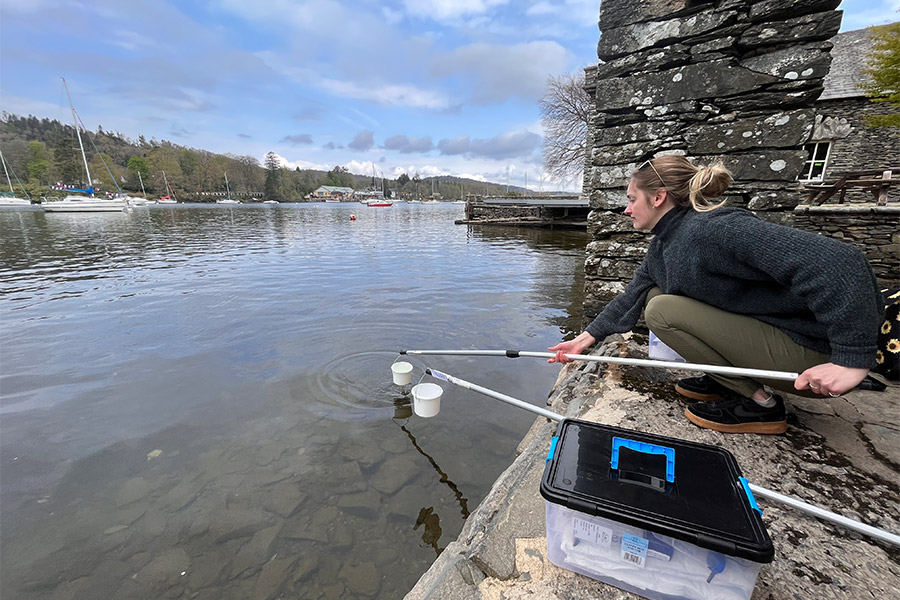8th Jun 2023
Protecting Lake Windermere
How The Love Windermere Partnership is working to prevent pollution and restore the ecosystem of the lake.
8th Jun 2023
How The Love Windermere Partnership is working to prevent pollution and restore the ecosystem of the lake.
A Lake in Distress – Fighting the effects of nature tourism
As outdoor enthusiasts, it is vital that we respect and care for the natural spaces that we all love so much. The impacts of adventure tourism on popular destinations cannot be ignored, and it’s crucial that we work towards preserving these places of outstanding natural beauty for future generations to enjoy and be inspired by.
Our friends over at the Fix the Fells Foundation are working tirelessly to repair and maintain the paths of the Lake District to protect the natural environment by reducing erosion, ensuring that visitors to the area can still access the stunning hills and mountains.
But it’s not just the pathways and hills that are at risk from tourism damage. Dickie Felton from Fix the Fells explains the impact that increased traffic to the area is having on the famous Lake Windermere.
An idyllic lakeside destination
Windermere is England’s largest lake and one of the nation’s most iconic.
Surrounded by fells in a UNESCO World Heritage Site, the lake is 11 miles long and almost one mile at its widest.
This wondrous place has been a mecca for visitors since the late 18th Century. In 1820 William Wordsworth published 'A Guide through the District of the Lakes in the North of England'. Twenty-seven years later the railway reached Windermere. But Wordsworth could never have predicted the Lake District would grow in popularity and now regularly attracts around 17m visitors each year – with a sizeable number travelling through or visiting Windermere.

An unfortunate consequence
This place of immense beauty has come under pressure in the last half-century. Nutrients, climate change, extreme weather patterns and the seasonal variations of tourist numbers are all putting the lake and its water quality under increasing pressure. Concerns have been raised about the health of the lake, in particular algal blooms and bacterial pollution, which are potentially harmful to wildlife and humans.
The early visitors to Windermere could not have foreseen the impact of climate change on this holiday destination. The average water temperature of Windermere has increased by +1.7C in the last 70 years.
Today the population living around the lake can double between winter and summer, putting an extra load of nutrients into septic tanks (small waste management systems at properties and businesses), wastewater treatment works and sewage facilities at campsites.
What can be done?
In the summer of 2022, the biggest-ever partnership of Windermere organisations to tackle these challenges and protect Windermere was formed. The Love Windermere Partnership was launched with members from a broad range of sectors with the range of expertise and influence needed to bring about action. Led by the Environment Agency, the partnership includes the Freshwater Biological Association; Lake District Foundation; Lake District National Park Authority; National Farmers Union; National Trust; South Cumbria Rivers Trust and United Utilities.
The Lake District Foundation is working with the Environment Agency to help prevent pollution caused by poorly maintained non-mains drainage systems.
Information packs went out to 1900 properties and businesses across Windermere with advice on how to maintain septic tanks and in turn, keep the lake healthy. Grants have been made available for homes, businesses and farms in and around Windermere to form community septic tank emptying schemes.
Better maintenance of septic tanks could contribute to better water quality at Windermere and significantly reduce septic tank maintenance costs.
South Cumbria Rivers Trust is working with volunteers to restore reed beds around the north of the lake, encouraging natural processes to remove nutrients from the lake sediment.
This spring United Utilities announced that Investment totalling £19m will be fast-tracked to help reduce storm water spills at Windermere.
The Fresh Water Biological Association is involving more than 100 community citizen scientists to test water quality around the lake. The fourth Big Windermere survey was completed recently, and the results will inform the strategy to care for the lake.

A place worth protecting
There has never been greater focus and interest in Windermere. Several thousand swimmers are set to leap into Windermere in early June when the three-day Great North Swim gets underway.
This weekend-long celebration of open-water swimming attracts participants from around the country and further afield. Swimmers can expect stunning scenery, the best of local food and drink, outdoor activities, culture, art, history, and thousands of like-minded people coming together.
A stone’s skim away from the start line, recreational swimmers will paddle and take an early morning dip at Miller Ground – one of Windermere’s most popular spots for open-water swimming and paddle boarders.
Situated at the very southern tip of Windermere, Fell Foot Park is a family-friendly place to play, explore and relax. Sweeping lawns offer plenty of space for games, picnics and gentle walks, while easy lake access makes the park perfect for paddling, swimming and boating.
It is the location of a popular Saturday morning Park Run and in warmer months it’s not unusual to see joggers complete the course and then go for a dip.

How you can help
Windermere is universally loved, a place enjoyed by thousands of people each week. It is a place that needs care and protection.
To find out more and support ongoing efforts to help look after lakes in the Lake District you can donate here.